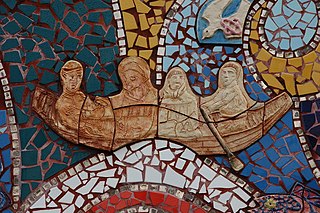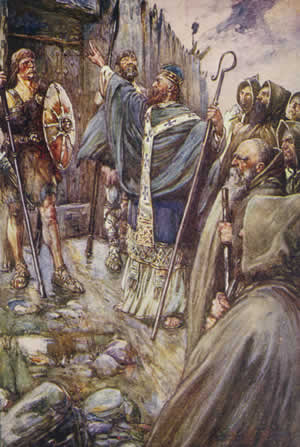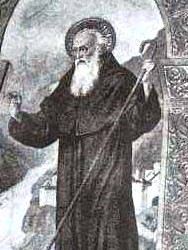
Columbanus was an Irish missionary notable for founding a number of monasteries after 590 in the Frankish and Lombard kingdoms, most notably Luxeuil Abbey in present-day France and Bobbio Abbey in present-day Italy.

Gall according to hagiographic tradition was a disciple and one of the traditional twelve companions of Columbanus on his mission from Ireland to the continent. However, he may have originally come from the border region between Lorraine and Alemannia and only met Columbanus at the monastery of Luxeuil in the Vosges. Gall is known as a representative of the Irish monastic tradition. The Abbey of Saint Gall in the city of Saint Gallen, Switzerland was built upon his original hermitage. Deicolus was the elder brother of Gall.

Luxeuil Abbey, the Abbaye Saint-Pierre et Saint-Paul, was one of the oldest and best-known monasteries in Franche-Comté, located in what is now the département of Haute-Saône in Franche-Comté, France.

Saint Comgall, an early Irish saint, was the founder and abbot of the great Irish monastery at Bangor in Ireland.

August 18 - Eastern Orthodox liturgical calendar - August 20
The Antiphonary of Bangor is an ancient Latin manuscript, supposed to have been originally written at Bangor Abbey in modern-day Northern Ireland.

Nilus the Younger, also called Neilos of Rossano was a Griko monk and abbot from Calabria. He was the founder of Italo-Byzantine monasticism in southern Italy. He is venerated as a saint in the Eastern Orthodox and Catholic churches, and his feast day is celebrated on September 26 in both the Byzantine calendar and the Roman Martyrology.
Jonas of Bobbio was a Columbanian monk and a major Latin monastic author of hagiography. His Life of Saint Columbanus is "one of the most influential works of early medieval hagiography."

The Hiberno-Scottish mission was a series of expeditions in the 6th and 7th centuries by Gaelic missionaries originating from Ireland that spread Celtic Christianity in Scotland, Wales, England and Merovingian France. Celtic Christianity spread first within Ireland. Since the 8th and 9th centuries, these early missions were called 'Celtic Christianity'.

Disentis Abbey is a Benedictine monastery in the Canton of Grisons in eastern Switzerland, around which the present town of Disentis grew up.

Attala or Atala was a disciple of Columbanus and his successor as abbot of Bobbio from 615.

Bobbio Abbey is a monastery founded by Irish Saint Columbanus in 614, around which later grew up the town of Bobbio, in the province of Piacenza, Emilia-Romagna, Italy. It is dedicated to Saint Columbanus. It was famous as a centre of resistance to Arianism and as one of the greatest libraries in the Middle Ages. The abbey was dissolved under the French administration in 1803, although many of the buildings remain in other uses.
Saint Bercharius was abbot of Hautvillers in Champagne. Descended from a distinguished Aquitanian family, he received his instruction from Saint Nivard (Nivo), Archbishop of Reims.
There is archaeological evidence of insular monasticism as early as the mid 5th century, influenced by establishments in Gaul such as the monastery of Martin of Tours at Marmoutier, the abbey established by Honoratus at Lérins; the abbey of Mont-Saint-Michel; and that of Germanus at Auxerre. Many Irish monks studied at Candida Casa near Whithorn in what is now Galloway in Scotland.
Eustace of Luxeuil, also known as Eustasius, was the second abbot of Luxeuil from 611. He succeeded his teacher Columbanus, to whom he had been a favorite disciple and monk. He had been the head of the monastic school.

Remiremont Abbey was an abbey that was founded as a house of nuns near Remiremont, Vosges, France. It later became a community of secular canonesses.

November 22 - Eastern Orthodox liturgical calendar - November 24
Bladulf, was a monk and priest of Bobbio Abbey, killed on the orders of the Lombard king Arioald, because Bladulf would not salute him, as being an Arian. It is said that Abbot Attala restored Bladulf to life and delivered Arioald from a diabolical possession, the punishment of his crime; and that this two-fold miracle led to Arioald's conversion.

March 9 - Eastern Orthodox liturgical calendar - March 11

Saint Babolen was Abbot of Saint-Maur-des-Fossés Abbey near Paris. He may have been Scottish in origin. His feast day is 26 June.











